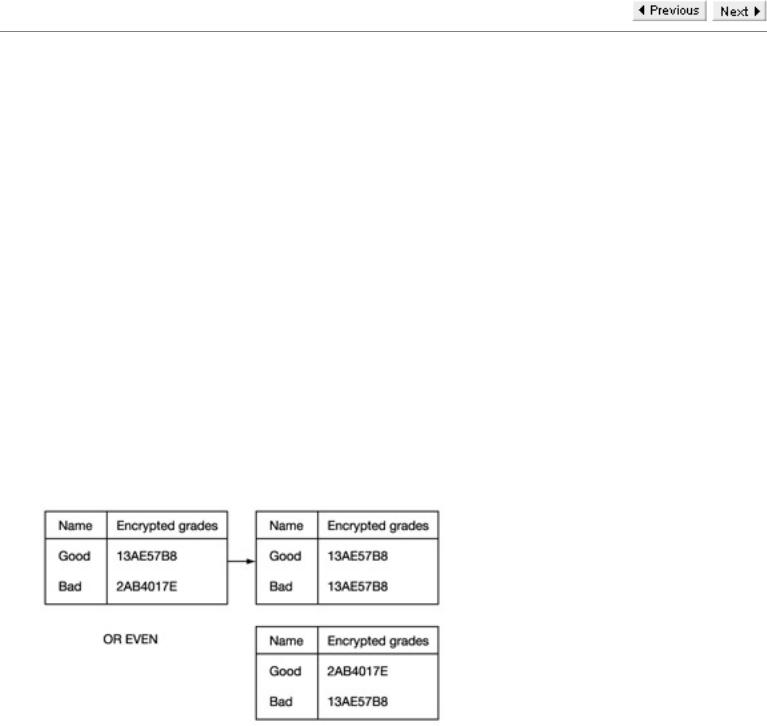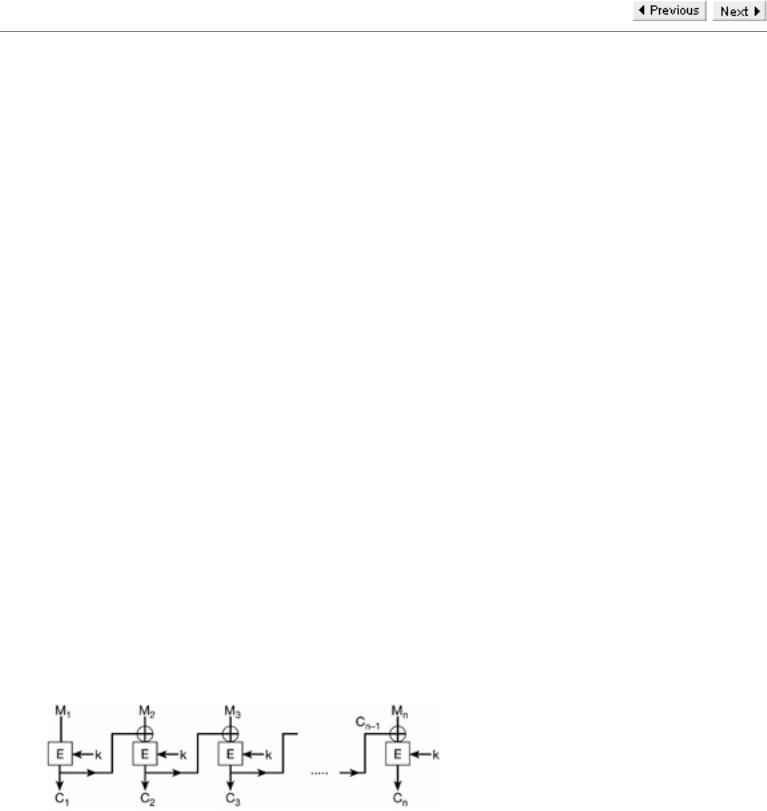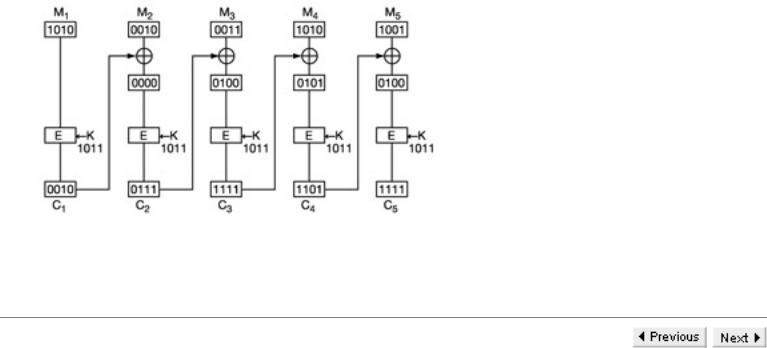
- •Table of Contents
- •BackCover
- •Cryptography-A Very Short Introduction
- •Chapter 1: Introduction
- •Using this book
- •Chapter 2: Understanding Cryptography
- •The basic concepts
- •Chapter 3: Historical Algorithms: Simple Examples
- •Caesar Cipher
- •Simple Substitution Ciphers
- •The statistics of the English language
- •The Playfair Cipher
- •Homophonic Coding
- •Polyalphabetic Ciphers
- •Vigenère Ciphers
- •Transposition Ciphers
- •Super-encryption
- •Some conclusions
- •Appendix
- •Chapter 4: Unbreakable Ciphers?
- •Perfect secrecy
- •The one-time pad
- •Chapter 5: Modern Algorithms
- •Bit-strings
- •Stream ciphers
- •Block ciphers (ECB mode)
- •Hash functions
- •Public key systems
- •Chapter 6: Practical Security
- •Realistic security
- •Practical exhaustive key searches
- •Attacks on public key systems
- •Chapter 7: Uses of Cryptography
- •Using symmetric algorithms for confidentiality
- •Authentication
- •Using symmetric algorithms for authentication and data integrity
- •Digital signatures
- •Certification authorities
- •Public Key Infrastructure
- •The need for trust
- •Chapter 8: Key Management
- •The key life cycle
- •Key hierarchies
- •Managing keys in networks
- •Using a trusted management centre
- •Key recovery and key back-up
- •Chapter 9: Cryptography in Everyday Life
- •A cash withdrawal from an ATM
- •Pretty Good Privacy (PGP)
- •Secure web browsing
- •Using a GSM mobile phone
- •References and further reading

Chapter 7: Uses of Cryptography
Team-Fly
Chapter 7: Uses of Cryptography
Introduction
So far we have assumed that our cryptographic algorithms are being used to provide confidentiality. However, there are many other applications. Whenever we use cryptography it is important that we check that it is helping us achieve our desired objectives. We illustrate a potential misuse of cryptography with an example.
In 1983 MGM produced a film called War Games. It became a cult film that highlighted the dangers of hacking. One synopsis describes the film by saying 'The fate of mankind rests in the hands of a teenager who accidentally taps into the Defence Department's tactical computer'. Its opening scene showed the teenager hacking into his university's computer system and changing his girlfriend's grades. At that time, many universities were storing examination results on databases that could be accessed remotely. Not surprisingly, they were concerned that their results might be vulnerable to the type of unauthorized manipulation depicted in the film and wanted to introduce appropriate protection.
One proposal was to encrypt each student's grades. However, this did not really achieve the objective and it is both important and interesting to understand why. It is easy to see what encrypting the grades achieves. The result is that anyone who hacks into the database does not see the grade of any individual student. Instead they see meaningless data attached to each name. Unfortunately, this does not necessarily prevent constructive alteration of grades by hackers. If a hacker has failed, but happens to know that a specific student has good grades, then they merely change the meaningless data by their name so that it is identical to that associated with the other student. Of course, if they do not know the precise grades of the other student, then they do not know their new grades. Nevertheless, they know that they now have a pass grade. This is just one of many instances where the use of encryption fails to meet the user's objectives. It is not the answer to all problems. Note also that, in this particular example, the algorithm has not been broken. In fact it has not even been attacked. All that has happened is that the user failed to analyse the problem correctly.
Suppose now that if, instead of encrypting only the grades, universities encrypted the complete database. Would this have achieved the objective of preventing a hacker changing grades? In this case, encrypting the complete database means that the complete file would be unintelligible to a hacker. However, even in this case, it may not be sufficient to protect against a hacker changing grades. Suppose, for instance, that each line of the file represented a student's name and grades. If the order in which the students appear is the alphabetical order of the complete class, then the attack discussed in the last paragraph would still be possible.
Before we concentrate on how cryptography might be used to protect stored information from being manipulated, we pause to consider whether or not it really matters if someone could alter the marks stored on any one particular database. It is, of course, absolutely crucial that students are credited with their correct grades. If the database being altered is not the only record available, then it might not be possible for the student to derive any benefit from the grades being changed in that particular record. The crucial requirement is probably that there should be some mechanism to warn all authorized users that the grades have been altered. Thus it may be that prevention of alteration is not vital, provided that any changes can be detected. This might mean that authorized users are warned not to rely on that database and to consult the master record. In many situations it is the detection of unauthorized changes that is required, rather than their prevention.
Cryptography is commonly used to ensure the detection of unauthorized alterations to documents. Indeed, at least for the commercial sector,
file:///D|/1/4303/Fly0031.html (1 von 2) [08.10.2007 12:51:17]

Chapter 7: Uses of Cryptography
the provision of confidentiality is no longer its major application. In addition to its traditional use for privacy, cryptography is now used to provide:
●data integrity: assurance that information has not been altered by unauthorized or unknown means;
●entity authentication: corroborating the identity of an entity;
●data origin authentication: corroborating the source of the information;
●non-repudiation: preventing the denial (this is usually by the originator) of the content of the information and/or the identity of the originator.
There are, of course, a number of standard (non-cryptographic) ways of protecting data from accidental corruption, for example, the use of a parity check or more sophisticated error-correcting codes. If, however, protection against deliberate alteration is required, then, since they depend only on public information, these techniques may not be sufficient. Anyone deliberately altering the information would encode the altered message appropriately so that the alteration was undetected. Thus, for protection against deliberate alteration, some value known only to the sender and (possibly) the receiver, such as a cryptographic key, must be used.
Team-Fly
file:///D|/1/4303/Fly0031.html (2 von 2) [08.10.2007 12:51:17]

Using symmetric algorithms for confidentiality
Team-Fly
Using symmetric algorithms for confidentiality
We have already identified some potential security risks if a block cipher is used to encrypt data in ECB mode. One is the possibility that someone with knowledge of corresponding plaintext and ciphertext blocks could manipulate the ciphertext blocks to construct a cryptogram which would decrypt into a meaningful message. The changes would not be detected by the receiver. We have already seen a small example of this. However, the emphasis here should be on the word meaningful. If a block cipher is being used in ECB mode then, clearly, the decryption algorithm can be given the ciphertext blocks in any order and it would be able to decrypt each one individually to produce a potential message. However, it is unlikely that the resultant decrypted data would form a coherent, intelligible message. Although the possibility of such attacks should not be ignored, the chance of them succeeding is small.
The more serious deficiencies of using ECB mode are that an attacker might be able to build dictionaries of known corresponding plaintext and ciphertext blocks for a given key and that ECB mode is vulnerable to attacks which rely on the statistics of the underlying language of the plaintext. The 'classic' example of such an attack is the one shown for Simple Substitution Ciphers in Chapter 3.
Each of these vulnerabilities exists because the blocks are enciphered independently of each other. Thus, for a given key, identical plaintext blocks result in identical ciphertext blocks. One way of trying to overcome this is make each ciphertext block depend not only on the corresponding plaintext block, but also on its position in the complete text. This was the approach adopted in the Vigenère Cipher. Such techniques certainly have a 'flattening' effect on the statistics of the language. However, a more common and more effective technique is to ensure that the ciphertext block corresponding to any given plaintext block depends on the contents of all previous plaintext blocks in the message. The two most common ways of achieving this are the use of Cipher Block Chaining (CBC) and Cipher Feedback (CFB) modes. We describe Cipher Block Chaining (CBC) mode.
Suppose that we have a message consisting of n message blocks, M1, M2,..., Mn that we wish to encrypt with a block cipher using a key K. For CBC mode the resultant cryptogram has n blocks, C1, C2,..., Cn, but now each of these cryptogram blocks depends on all previous message blocks. The way in which this is achieved is that each cryptogram block, other than C1, is obtained by encrypting the XOR of the corresponding message block with the previous cryptogram block. Thus, for instance, C2 is the result of encrypting M2 C1. So, if we write EK to represent the encrypting process with key K, we have C2 = EK(M2 C1). Clearly the first message block has to be treated differently. One option might be to let C1 be EK(M1). Another common option is to use an initialization value (IV) and let C1 be the result of encrypting M1 IV. (Note that if IV is all Os, then these two options are identical.) Since C1 depends on M1, and C2 depends on M2 and C1, it is clear that C2 depends on both M1 and M2. Similarly, since C3 = EK(M3 C2), C3depends on M1, M2, and M3. In general, each ciphertext block
depends on the corresponding plaintext block and all previous plaintext blocks. This has the effect of linking all the ciphertext blocks together in the correct specific order. It not only destroys the underlying statistics of the message, but also virtually eliminates the possibility of manipulation of the ciphertext.
Cipher Block Chaining
We now illustrate how CBC mode works with the small example of a block cipher that we used in Chapter 5 and compare the cryptograms by
using the same algorithm and key in EBC mode and CBC modes. Unfortunately the example looks more complicated than it really is. Readers are encouraged to persevere. However, you will not be disadvantaged if you jump to the beginning of the next section.
For this example, the plaintext, written in HEX, is A23A9 and the key K = B. The encryption algorithm XORs the plaintext block with the key and the ciphertext block is obtained by rotating the bits of M K one position to the left. For CBC mode, we use IV of all Os, so that C1 is
the same as for ECB mode. Thus C1 is obtained by rotating M1 K = A B = 1010 1011 = 0001 to get 0010. So C1 = 2.
file:///D|/1/4303/Fly0032.html (1 von 2) [08.10.2007 12:51:17]

Using symmetric algorithms for confidentiality
To compute C2 the process is as follows:
M2 C1=2 2=0010 0010 = 0000
0000 K=0 D = 0000 1011 = 1011
Performing the rotation gives C2 = 0111 = 7. To compute C3 we have:
M3 C2=3 7=0011 0111=0100
0100 K = 0100 1011=1111
Performing the rotation gives C3 = 1111 = F. To compute C4 we have:
M4 C3=A F=1010 1111 = 0101
0101 K=0101 1011=1110
Performing the rotation gives C4 = 1101 = B. We leave the reader to compute C5 (answer given below).
Thus, from the same message we obtain two cryptograms, depending on the mode of encryption.
Message: |
A 2 3 A 9 |
|
Cryptogram using ECB mode: |
2 3 |
1 2 4 |
Cryptogram using CBC mode: |
2 7 |
F B F |
Even from our small example, it is clear that there is no obvious correlation between the positions of identical message blocks and the positions of identical ciphertext blocks.
A diagram to illustrate the CBC example
When block ciphers are used in CFB mode, the process is different. However, the resultant effect is similar in the sense that each ciphertext block depends on the corresponding plaintext block and every preceding plaintext block in the order in which they appear in the message. For details of CFB mode see Menezes, van Oorschot, and Vanstone, Handbook of Applied Cryptography.
Team-Fly
file:///D|/1/4303/Fly0032.html (2 von 2) [08.10.2007 12:51:17]
